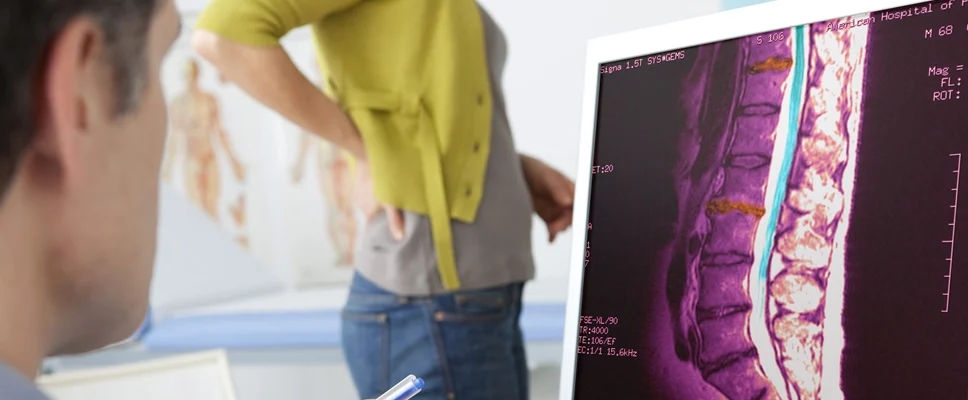
What is the Spine Made Of?
Your spine is made up of 33 small bones called vertebrae, which are supported by shock-absorbent spinal discs and sturdy facet joints. The vertebrae of the spine are classified into four levels:
- The Cervical Spine: 7 vertebrae that form the upper back
- The Thoracic Spine: 12 vertebrae that form the middle back
- The Lumbar Spine: 5 vertebrae that form the lower back
- The Sacral Spine: 9 fused vertebrae that form the sacrum and coccyx
Together, the vertebrae constitute the vertebral column. In a healthy spine, the vertebral column appears straight when viewed front to back, but has a smooth S-shaped curve when seen from the side. The vertebrae themselves are rectangular in shape. Individually, each vertebra helps the spine move fluidly and keeps the body upright and stable. Like any other bone, vertebrae can be fractured, or broken. When this occurs, localized pain, as well as dysfunction in movement, can occur.
What Are Spinal Compression Fractures?
A spinal compression fracture also referred to as a vertebral compression fracture (VCF), occurs when a vertebra collapses due to degeneration or trauma. Most compression fractures occur in vertebrae that have already been weakened by osteoporosis or other diseases that weaken bone, such as cancer. The fracture occurs when the bone has become so brittle that the vertebrae deteriorates and can no longer support the spinal column in daily activities. When this occurs, the front of the vertebrae caves in, forming a wedge-shape.
However, spinal compression fractures can also occur as a result of trauma. These types of fractures generally occur from too much pressure on the vertebral body, resulting from a combination of the body bending forward and downward pressure applied to the spine. Traumatic spinal compression fractures typically result from sudden collisions or falls.
While “compression fracture” refers to the collapsing of the front of the bone, other types of spinal fractures include:
- Crush Fracture: The entire vertebra breaks rather than just the front
- Burst Fracture: Both the front and back walls of the vertebra begin to sink in, causing the entire bone to lose height.
What Happens After a Vertebra Fractures?
When a vertebra fractures, it alters the shape of the bone. A normal, healthy vertebra will resemble a small square. A vertebra that has suffered a fracture will resemble a wedge-shape. This is because most compression fractures happen in the front of the vertebra. When enough hairline fractures occur, the front part of the bone collapses. The back of the vertebra faces the spinal canal and is made of harder bone, therefore, it typically stays intact after a fracture.
Once one of the spinal vertebrae becomes wedge-shaped, both the strength and the shape of the spine can change. The loss of bone makes your spine shorter, causing you to lose height. Wedge-shaped vertebrae stacked on top of one another create a more exaggerated S-curve in the spine, giving you a stooped posture. This bent posture is commonly referred to as a dowager’s hump, but doctors call this condition kyphosis. Once this change in posture occurs, it can become irreversible.
Causes of Spinal Compression Fractures
Osteoporosis is the most common cause of spinal compression fractures. Those with osteoporosis are at constant risk of bone fractures, given their declining bone density. Thinning bones can collapse during normal activity, such as lifting a light object, missing a step, or even sneezing. In patients with moderate osteoporosis, it typically requires increased force or trauma, such as a fall, to cause a spinal compression fracture.
Common causes of vertebral compression fractures include:
- Osteoporosis
- Metastatic disease
- Cancer
- Falls
- Car accidents
- Sports impact injuries
- Forceful jumps
What Are Risk Factors For Vertebral Compression Fracture?
The thoracic spine is the most at risk for developing spinal compression fractures, particularly in the lower vertebrae of the middle back or in the lumbar spine. Compression fractures rarely occur above the upper thoracic spine, but they are possible.
Those lacking bone density are at constant risk of developing a vertebral compression fracture. Likewise, those battling cancer are at risk of developing a fracture, as the spread of cancer cells to the spine can make the vertebrae susceptible to damage (metastatic disease). However, various genetic factors and lifestyle habits can put others at risk for sustaining a VCF.
Aging: Our bones naturally lose density as we age, increasing the risk of fracture.
Being Female: Bone loss is more common in women, especially post-menopausal women. When estrogen levels begin to decrease, bones can lose density and become susceptible to fractures.
Medications: Oral steroids, diabetes medications, and anti-depressants can all harm bone health, weakening vertebrae.
Pre-Existing Spinal Fracture: Having one spinal fracture greatly increases your chances of having another.
Unhealthy Habits: Excessive alcohol consumption, smoking cigarettes, and living a sedentary lifestyle can all negatively impact bone density. Alcohol and smoking can affect your body’s ability to absorb calcium, an inactive lifestyle makes bones weak.
Symptoms of Spinal Compression Fractures
Unfortunately, a majority of people believe that back pain is just part of aging. For those suffering osteoporosis, chronic back pain can fool them into believing that the ache of a spinal compression fracture is just another symptom of their condition. In fact, this is a major factor as to why two-thirds of spinal compression fractures are never diagnosed. The misconception that back pain goes hand-in-hand with aging and arthritis causes many patients to overlook critical symptoms, which can lead to the fractures worsening, or the entire bone collapsing.
Symptoms of spinal compression fractures to watch for include:
- Sudden onset of back pain
- An increase of pain while standing or walking
- Pain that decreases while lying on the back
- Pain when twisting or bending
- Limited spinal mobility
- Eventual height loss
- Eventual deformity and disability
How Are Vertebral Fractures Diagnosed?
At ChiroCare of Florida, spinal fracture treatment must begin with proper diagnosis. Our physicians begin with a complete review of a patient’s medical history, as well as a thorough physical examination. Once you and your physician have reviewed any present symptoms, the next step in diagnosis is medical imaging. Your chiropractor may request testing such as:
- X-Rays
- Computed Tomography (CT Scan)
- Magnetic Resonance Imaging (MRI)
In addition to eliminating any other possible prognosis, these tests can allow chiropractic insight to the spinal vertebrae, which lie deep beneath layers of muscle and ligaments. Diagnosis is typically made when a vertebral bone in the spine has decreased at least 15 to 20 percent in height due to a fracture.
Treatment for Spinal Compression Fractures
At ChiroCare of Florida, chiropractic spinal compression fracture treatment comes in stages. The first step towards healing and wellness comes by stabilizing the vertebrae and alleviating acute pain. Not only will this prevent further damage, but it will also make you more comfortable throughout treatment. To do this, a chiropractor will likely provide a back brace to provide external support. Much like a cast for a broken limb, a back brace takes pressure off the painful bone, limits your movement, and allows the injured vertebrae a chance to heal.
Next, a chiropractor will utilize decompression techniques, such as flexion and extension therapy, to reduce stress on the fracture and promote healing. Corrective chiropractic, including spinal manipulation and periodic adjustments, can help to realign and stabilize vertebrae. Further pain-relieving and stabilizing chiropractic therapies for vertebral compression fracture treatment include:
When spinal compression fractures are the result of osteoporosis, osteoporosis treatment is a key aspect of a patient’s therapy. While loss of bone density cannot be reversed, chiropractic can help to slow the damage and strengthen the spine. This puts a patient less at risk of sustaining further spinal fractures, and also helps to alleviate the pain and discomfort that accompanies osteoporosis.
Seeking Spinal Compression Fracture Treatment
Following a spinal compression fracture, there is a high likelihood that you will not require surgery, addictive narcotics, or invasive injection. With proper care and guidance, compression fractures can heal on their own in three months. However, left untreated, spinal compression fractures can result in disability.
Spinal compression fracture treatment in South Florida starts at ChiroCare of Florida. With 11 offices throughout South Florida, a ChiroCare of Florida office is always nearby. A trusted ChiroCare of Florida physician is ready to help you heal. What are you waiting for? Stop fractures in their tracks and get on the path to wellness today. Contact us now to learn more.


